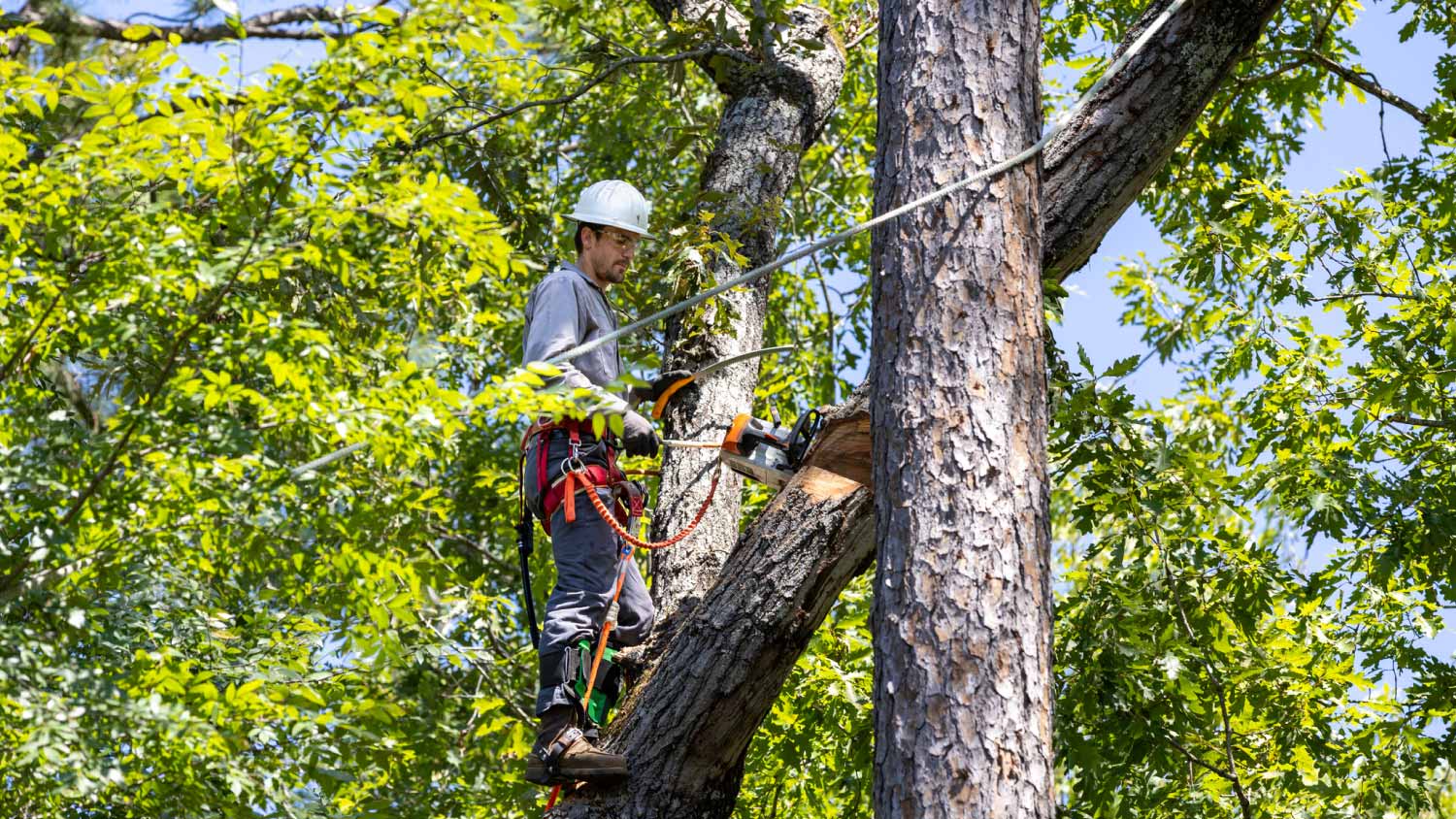
Discover what the current average tree removal cost is based on different factors to know how much it will cost to take care of a dead or troublesome tree on your property.
Time your spray to keep the bugs away


Apply preventative dormant oils to fruit trees during early spring, just before trees end their dormancy period.
You can apply other treatments, such as fungicides and insecticides, to fruit trees throughout the growing season.
Never spray fruit trees while they’re in blossom, as this can harm beneficial pollinators.
You may love your fruit tree, but unfortunately, so do the bugs who nest and feed on it. That’s why learning when to spray your fruit trees for bugs is a vital aspect of year-round care, and getting the timing right is essential for success. This guide will cover when to spray fruit trees for bugs, as well as other factors to consider when planning out your treatments.

The best time to spray preventive treatments on fruit trees is in early spring while the trees are still dormant. Applying preventative treatments, known as dormant oils, will help you get a leg up against pesky bugs and ensure you have a healthy tree throughout the growing season.
These are the main factors to consider when you’re deciding when to spray fruit trees for insects.
The local weather has a significant impact on the optimal timing for spraying. In colder regions, trees stay dormant for a longer time, providing more leeway for applying dormant oils. On the other hand, in warmer areas, the growing season begins earlier, so you’ll need to apply dormant oils earlier. It’s important to refrain from spraying on windy or rainy days, as the spray could drift away or wash off before it can be effective.
Knowing the life cycles of the main pests and tree diseases that affect your region is a crucial determining factor for when to spray fruit trees for bugs. For example, some insect eggs hatch in early spring, so applying a dormant oil spray just before bud break can effectively suffocate overwintering insects and their eggs.
The type of treatment will also impact the optimal time for spraying fruit trees. If you have any concerns about the health of your fruit tree, or if you’re not sure if pests are the culprit, it’s best to hire an arborist to help you find the best treatment plan. Here are the basic timelines by the type of spray:
Insecticides: Apply throughout the growing season when bugs are active, avoiding the flowering period.
Dormant oils: Apply during the dormant seasons when temperatures are above 40 degrees Fahrenheit to smother overwintering pests like mites and aphids.
Fungicides: Apply before bud break and throughout the growth season as needed, avoiding the flowering period.
The growth cycle of fruit trees calls for targeted pest control at different stages, from dormancy to harvest. In early spring, as temperatures rise, apply horticultural or dormant oil sprays like neem oil to tackle overwintering pests. Before bud break, spray fungicides to prevent fungal diseases and set your tree up for a healthy growing season. During bloom, avoid spraying to prevent damaging flowers and harming pollinating bees. After that, you can apply insecticides throughout the growing season to keep the bugs at bay.

The worst time to spray fruit trees is when they are blossoming, as sprays can harm bees and other beneficial insects that pollinate the tree. After the petals fall, when fruit forms, you can resume spraying throughout the summer for ongoing protection.
The cost to spray trees typically ranges between $100 and $400 per tree, depending on the size of the tree and the type of pesticide. You can save by purchasing at-home treatments, but finding the right pro to spray your trees is well worth the cost if it’s within your budget.
Spraying fruit trees yourself is a cost-effective option, with a typical investment of $25 to $50 for the insecticide. You’ll need basic equipment, such as a sprayer and protective gear, and it’s essential to follow safety guidelines, especially when dealing with chemicals. DIY spraying will take a few hours, depending on how many trees you have.
While DIY spraying can save you money, there’s a hefty margin for user error and it’s easy to pick the wrong type of spray or use it incorrectly. Aside from the treatment being ineffective, it’s possible that you can harm the tree, wildlife, and the surrounding landscape. Hiring a local tree maintenance professional will ensure the proper application of the most effective treatment, giving your fruit tree the best chance for a healthy and fruitful growing season. These pros bring specialized knowledge and tools to ensure the treatment is effective as well as safe for your trees and the surrounding environment.
From average costs to expert advice, get all the answers you need to get your job done.

Discover what the current average tree removal cost is based on different factors to know how much it will cost to take care of a dead or troublesome tree on your property.

How much does a palm tree cost? The answer depends on the type of tree, its size, and other factors. Find out how much a new palm tree costs.

The cost of tree stump removal depends on size, removal method, location, and more. Our guide will show you how much stump removal costs.

If you want your peach tree to provide you with fruit all summer long, you’ll need to keep up with pruning. Learn when and how to prune a peach tree.

What is an arborist and do they cut down trees? Learn what an arborist is, the services they offer, and when to hire one.

Are surface roots a problem? Maybe not, but if an issue does crop up, it could be costly. Here’s what to do when you notice tree roots in your lawn.